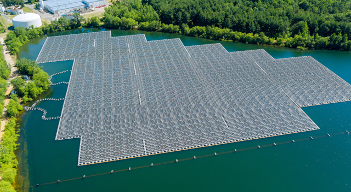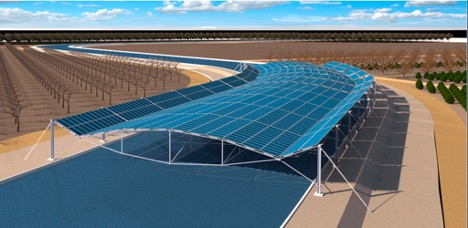Energy Innovation partners with the independent nonprofit Aspen Global Change Institute (AGCI) to provide climate and energy research updates. The research synopsis below comes from AGCI’s Tanya Petach. A full list of AGCI’s updates is available online.

In arid river basins around the globe, substantial water supply is lost through evaporation. A recent estimate of global reservoir evaporative losses found that annual water volume loss was equivalent to 70 percent of all global municipal water withdrawals in 2010. Nearly one-third of all reservoirs evaporative losses in the world occur in Canada and the United States. Evaporation rates in the United States are especially high, due in part to the fact that the two largest U.S. reservoirs (Lake Powell and Lake Mead) are located in the hot, dry deserts of the Southwest. And evaporation doesn’t just impact reservoirs—it also desiccates irrigation canals, ditches, and holding ponds.
Lake Powell and Lake Mead, both on the Colorado River, have experienced long-term drying trends since the turn of the millennium. Due to a combination of prolonged drought, water overuse, and warming temperatures, these reservoirs lost 61 percent of their full storage volume from January 2000 to April 2023. While this year’s hefty Rocky Mountain snowpack helped alleviate the impacts of the last 23 years of drought, one good snow year isn’t enough to bail the Colorado River out of long-term drought.

As water availability decreases in the Colorado River Basin, water use is more highly scrutinized. Alongside municipal, agricultural, and industrial users, evaporation is a stealth water consumer. The Southern Nevada Water Authority recently estimated that approximately 12 percent of the Colorado River’s total annual flow is lost to evaporation and other system elements (e.g., infiltration into ditch banks). In a water-stressed basin where the federal government pays billions of dollars for modest water savings, 12 percent loss adds up to a lot of water. Currently, these losses aren’t well accounted for in the Lower Colorado River, but some experts are urging policymakers to do just that.
While reservoir evaporation contributes to water scarcity in the Colorado River and other arid river basins, water managers are beginning to focus on mitigating evaporative losses. One approach to attenuating this loss is to cover reservoirs and irrigation ditches in shading materials such as the 96 million “shade balls” that were deployed in 2015 to shade Los Angeles Reservoir in California. In recent years, focus has shifted to shading reservoirs and irrigation infrastructure in dual-purpose materials such as photovoltaics, or PV. Pairing PV with water infrastructure has centered around two techniques: floating PV and PV-covered irrigation canals.
Floating photovoltaics involve the installation of solar panels on top of foam, buoys, and other structures that float on the surface of reservoirs, lakes, and ponds. These systems tend to produce energy more efficiently than land-based PV, due in large part to the cooler temperatures of PV over water bodies than on land. As a result, pairing PV with water infrastructure has gained momentum in recent decades as a technique to decrease reservoir evaporation and increase renewable energy production.
Floating photovoltaics are thriving in Asia, which hosts 97 percent of globally installed floating PV, primarily in China, Japan, and Korea. This win-win technology is enticing to reservoir operators, power companies, and municipalities. Project locations include Alicante, Spain, where seven percent of a small irrigation reservoir was covered in floating PV to offset agricultural power needs; the United Kingdom, where six percent of the Queen Elizabeth II reservoir was covered in floating PV for municipal power generation; and Colorado, where the town of Walden is using floating PV to offset power requirements for water treatment.
These plants are relatively new, so energy yields and water savings are far below their full global potential. Theoretically, covering 30 percent of the 100,000 reservoirs around the globe with floating PV has the potential to yield 9,434 terawatt-hours annually, according to a Nature Sustainability article by Yubin Jin and colleagues published earlier this year—the equivalent of approximately 40 percent of global electricity use in 2021. Since reservoirs are often located near communities and metropolitan areas, floating photovoltaics have the potential to produce large quantities of power close to energy consumers. This co-location strategy can decrease transportation and line losses, increasing the overall efficiency of the system. Jin and colleagues estimate that over 150 metropolitan areas could become self-sufficient with local floating PV plants. Globally, producing energy with floating PV on reservoirs could potentially save 106 cubic kilometers of water from evaporative losses each year, a volume equivalent to almost 25 percent of annual household water use in the United States.
The two major reservoirs in the Lower Colorado River remain part of this theoretical future yield. Neither Lake Powell nor Lake Mead has yet tapped into floating PV to curb reservoir evaporation—though studies suggest that 10 percent coverage of Lake Mead could yield enough water savings and power production for Las Vegas and Reno combined.
While the sunny Southwest is slow to adopt floating PV on reservoirs, there is a healthy appetite for PV-covered irrigation canals. Inspired by a University of California, Merced study by Brandi McKuin and colleagues that highlighted potential water savings and energy production from PV-covered irrigation canals in the region, the Turlock Irrigation District in California’s Central Valley is poised to break ground on a project deploying PV over its irrigation canals this fall. The Turlock Irrigation project is a partnership between the irrigation district, a private solar company (Solar AquaGrid), the California Department of Water Resources, and a research group at the University of California, Merced. In a similar vein, the Gila River Indian Community in central Arizona received funding this year from the Bureau of Reclamation for water conservation infrastructure, including PV-covered ditches and canals. And the appetite for PV-covered irrigation infrastructure is far from sated. A letter to the Secretary of the Interior in July, 2023, from a variety of advocacy organizations, requested urgent action to deploy more photovoltaics over irrigation canals.

While the potential from floating PV on reservoirs and PV-covered canals is massive, the technology remains relatively unproven. Environmental concerns include metal leaching, ecosystem impairment, and decreased light intensity in aquatic ecosystems under the installations. Results from a pilot study on Oostvoornse Lake in the Netherlands show that floating photovoltaics reduce light intensity by 70 to 100 percent under installations, with potential cascading impacts on lake ecosystems. Yet researchers note that traditional PV installations also cause considerable environmental impacts, and direct comparisons are complex. In addition to environmental risks, floating photovoltaics have higher installation costs and raise more maintenance concerns than land-based solar.
Despite these challenges, pairing PV and water infrastructure has enormous potential to help re-stabilize water supplies in the Colorado River and other drought-stricken regions around the planet. In the arid Southwest, intensified scrutiny on evaporative losses, requests for increased federal interest for paired water infrastructure-PV systems, and bold exemplar projects like the PV-covered canal systems in the Turlock Irrigation District and Gila River Indian Community are ushering in a new approach to water management, with massive potential for expansion. As reservoir evaporation continues to squander large quantities of water in arid regions worldwide, it is time to keep the momentum moving forward toward next-generation sustainable solutions at the water-energy nexus.
Featured Research
Bax, V., van de Lageweg, W. I., Hoosemans, R., & van den Berg, B. (2023). Floating photovoltaic pilot project at the Oostvoornse lake: Assessment of the water quality effects of three different system designs. Energy Reports, 9, 1415-1425.
Essak, L., & Ghosh, A. (2022). Floating photovoltaics: A review. Clean Technologies, 4(3), 752-769.
Fleck, J., & Kuhn, E. (2023). An Historical Perspective on the Accounting for Evaporation and System Losses in the Lower Colorado River Basin. Science Be Dammed Working Paper, 4.
Hayibo, K. S., Mayville, P., Kailey, R. K., & Pearce, J. M. (2020). Water conservation potential of self-funded foam-based flexible surface-mounted floatovoltaics. Energies, 13(23), 6285.
Jin, Y., Hu, S., Ziegler, A. D., Gibson, L., Campbell, J. E., Xu, R., … & Zeng, Z. (2023). Energy production and water savings from floating solar photovoltaics on global reservoirs. Nature Sustainability, 1-10.
McKuin, B., Zumkehr, A., Ta, J., Bales, R., Viers, J. H., Pathak, T., & Campbell, J. E. (2021). Energy and water co-benefits from covering canals with solar panels. Nature Sustainability, 4(7), 609-617.
Pimentel Da Silva, G. D., & Branco, D. A. C. (2018). Is floating photovoltaic better than conventional photovoltaic? Assessing environmental impacts. Impact Assessment and Project Appraisal, 36(5), 390-400.
Ramasamy, V., & Margolis, R. (2021). Floating photovoltaic system cost benchmark: Q1 2021 installations on artificial water bodies (No. NREL/TP-7A40-80695). National Renewable Energy Lab.(NREL), Golden, CO (United States).
Schmidt, J. C., Yackulic, C. B., & Kuhn, E. (2023). The Colorado River water crisis: Its origin and the future. Wiley Interdisciplinary Reviews: Water, e1672.
Sen, A., Mohankar, A. S., Khamaj, A., & Karmakar, S. (2021). Emerging OSH issues in installation and maintenance of floating solar photovoltaic projects and their link with sustainable development goals. Risk management and healthcare policy, 1939-1957.
Tian, W., Liu, X., Wang, K., Bai, P., Liu, C., & Liang, X. (2022). Estimation of global reservoir evaporation losses. Journal of Hydrology, 607, 127524.